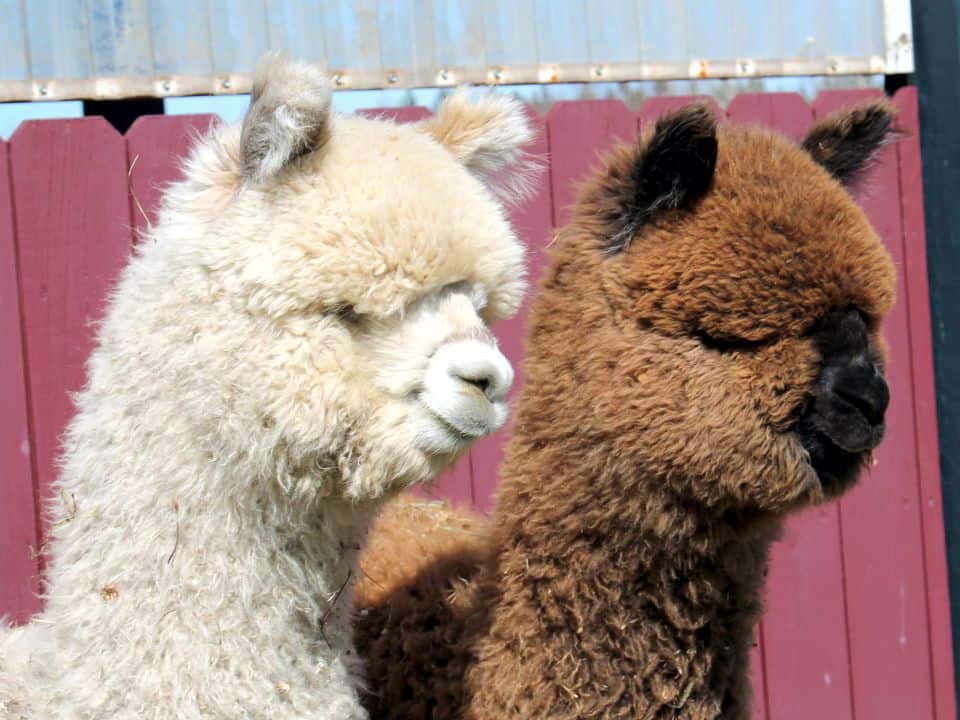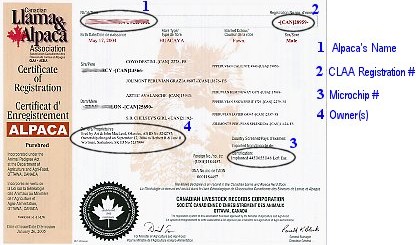
With the purchase of your first alpaca you will enter an exciting and rewarding industry. Your alpaca purchase should be an enjoyable and exciting experience with no surprises. As a service we offer the following alpaca purchase tips to all new participants.
These Minimum Breed Standards are provided with the express permission of the Canadian Llama & Alpaca Association (CLAA).
The Canadian Llama and Alpaca Association (CLAA) is incorporated under the Animal Pedigree Act and as such is recognized as the official Alpaca Registry in Canada.
Buyers should request and check registration and ownership of the registered alpacas of interest. Looking at the "Certificate of Registration" is the easiest way.

When looking at purchasing alpacas, there are a number of factors to consider. The initial dollar investment in the animals is usually significant, so spending some time setting goals and examining alternatives beforehand can be extremely important. Learning the basic facts about the industry will assist you in making appropriate choices for your particular situation.
Alpaca registries currently exist in Canada (CLAA), U.S.A. (AOA), Great Britain , Australia and Germany. Alpacas that are bred in Canada and are registered in either the CLAA or AOAI registries, or both, have registration certificates issued that list the pedigree or lineage of the alpaca. Parent verification is required for registering animals with either the CLAA or ARI. In the past this was done by blood typing, but now is done by a DNA testing procedure. This provides a great deal of certainty with respect to the lineage of any pedigreed, Canadian-bred alpaca.
The alpaca industry views pedigree as a very important tool to be employed in the continual improvement of the animals and their fibre, thus enhancing the marketability of alpacas in Canada and globally. It allows breeders to identify desirable characteristics that prove to be predominantly inheritable in certain bloodlines and to incorporate those characteristics in their own breeding programs by using those bloodlines. It also allows breeders to eliminate bloodlines that tend to pass on undesirable characteristics. Assessing alpacas from earlier generations of an animal's pedigree and related pedigrees is the only way to get beyond the way an animal looks (its phenotype) and assess the genetic potential it has to offer. That is why some agree that an animal with several generations of pedigree information can be more valuable than a similar animal with limited pedigree information.
With pedigree information, you can check out the parents and grandparents, siblings, half siblings and other related animals. Have the related animals all tended to have denser fibre than average or is this the first alpaca in this line to demonstrate higher density? Is the fibre of these bloodlines tending to become finer and denser with each generation or is it all over the map? Are there any physical or conformation problems that can be traced in the bloodlines? Are the breeders represented in the pedigree reputable, with breeding program goals that compliment yours? All of this information can be gathered to support your ultimate decision on which alpacas best meet your personal goals.
The CLAA and AOA registries are now closed to unpedigreed alpacas, however in previous years alpacas imported from South America were, in certain circumstances, registered in either. They came without parentage verification or pedigree information. The screening that was performed on these animals dealt with phenotype, i.e., assessing the way the animal looked. There was no process available to assess the genotype or genetic material that the animal had to offer. It may have been free of defects or it may have carried significant and undesirable recessive genes that did not show up in its physical appearance. These genes will only show up in the progeny of the animal as it is integrated into a breeding program. For this reason, Canadian-bred pedigreed alpacas can be a significant advantage to someone considering purchasing alpacas.
Feeding practices can have a significant impact on an animal's fibre. In their native habitat in South America, alpacas forage on poor quality scrub vegetation, low in protein and sparse in distribution. They walk upwards of five kilometres per day to obtain the feed required. Due to this low protein diet and the exercise in finding it the fleece of these animals can be very fine. We have found that Alpacas on lush high protein grass and no opportunity to exercise in North America become obese and the fibre coarsens. In this case it would be logical to say that we must not feed our alpacas too much as they are not designed for such rich food. We must remember however, that the alpacas on the altiplano generally only give birth once every three to four years and then the mortality rate of the cria is 40%. These figures are not acceptable to the North American breeder. We are therefore asking our animals to be much more productive and need to replace the nutrients and energy being used to reproduce continually. So, we must strike the correct balance. Our males who are not working as hard as the females can be on very low protein diets with low but correct supplement. Our Hembras (females) need to have their diet carefully worked out in order that they do not lose condition while lactating and while in gestation. The goal should be to maintain properly fed, healthy alpacas. In comparing the fleece qualities of the various alpacas available for purchase, allowances must be made for the differences in nutrition that may exist. This can be expected in your own operation as well. Nutritional differences can vary from country to country as well as from farm to farm. This should be considered carefully when comparing the measured micron count of the fleeces of different alpacas.
Another factor that may have an impact on fibre quality is the age of the alpaca. Babies, called crias, generally start out finer fleeced than adults. The fibre usually matures with the animal. The micron measurement of a fleece at two years of age gives a better prediction of the quality of the fleece that animal will produce at five years of age than does a similar measurement taken at one year or younger. Therefore, when comparing the fleece of alpacas that are available for purchase, some consideration should be given to the age of the animals. In general, an animal that maintains its fine fleece production over a number of years is superior to one whose fleece becomes coarse with age.
It is important to visit as many farms as possible and view as many animals as possible when looking for alpacas to purchase. Try to develop your own image of what good alpaca conformation looks like and identify the flaws in conformation you want to avoid. Ask breeders what they look for in quality stock. Put your hands into as many fleeces as possible to get an idea of the variations in fibre quality and density that are produced by different alpacas.
Annual sales events and shows are becoming increasingly common. Attending shows, where alpacas are judged on fleece and conformation, and going to sales before you are ready to buy may be another way of fine tuning your mental picture of the desirable alpaca. As well, keep in mind that different breeders may have different preferences for conformation, bloodlines and country of origin, and may be pursuing and promoting their own specific goals in their breeding programs. Each alpaca must be considered on its own merits in the context of the goals that you set for your breeding program. However, certain common goals are important if we are to improve Canada's national herd and eventually compete in the world market. We all should be breeding for dense, fine fleeces, and away from conformational faults, so that our alpacas are healthy and have a strong body frame to bear their valuable fleeces and cria.
Alpacas require good quality grass hay or pasture (between 10 – 15 % protein), mineral supplements and clean, fresh drinking water. They adapt very well to the Canadian climate, three-sided shelters and housing will protect the animals but a more substantial shelter such as a barn is preferable. It is very important that alpacas are shorn annually to keep them comfortable and prevent them from suffering from heat-stress. Not shearing poses a health hazard. Alpacas should always have access to shade.
Investing in this enjoyable and rewarding livestock should be done only after obtaining as much information as you can possibly garner. As in any venture, the motto 'buyer beware' applies. There is no need to feel rushed or pressured. The value of visiting and talking to as many breeders as possible cannot be stressed enough. Breeders should be able to provide pedigree verification (registration), breeding and birthing records, as well as medical records (deworming, vaccination, etc.). Gather information on what is required to properly look after the animals. These should include facilities, fencing, shelters, transporting requirements, veterinary care, feed, and any daily, monthly or yearly medical necessities. Research the availability of after-sales support. Reputable breeders will offer information on alpaca care, as well as telephone support and the benefit of their experience. Buying from a breeder who provides good after-sales support can make a tremendous difference in your chances of establishing a successful operation and enjoying the start-up process.
For information about alpaca care, fibre production and more, please complete the request form.